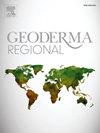Physically protected carbon stocks in a Brazilian Oxisol under homogeneous forest systems
IF 3.3
2区 农林科学
Q2 SOIL SCIENCE
引用次数: 0
Abstract
The soil organic carbon (SOC) stock and its occlusion within aggregates is at the center of discussions regarding climate change and global warming, as it is one of the mechanisms capable of mitigating the effects of these phenomena. Despite this, studies on the topic in tropical soils under native forest species plantations are still scarce. Therefore, we developed this study asking how SOC and occluded carbon stocks in aggregates respond to homogeneous Pterogyne nitens (N-fixing species) and Eucalyptus urophylla plantations when compared to a native forest? The study was conducted in Oxisol under three forest systems: two homogeneous plantations (P. nitens and E. urophylla) and a native forest (NF), located in the State of Bahia, Brazil. Litter and soil samples were collected up to a meter deep. The soil samples were subjected to physical fractionation by wet sieving, obtaining three size classes of water-stable aggregates: macroaggegates (2000–250 μm), microaggregates (250–53 μm) silt+clay (< 53 μm). The macroaggegates and microaggegates were sonicated to separate free and occluded particulate carbon. The carbon in whole soil and occluded in the aggregates were determined by the wet acidified oxidation method. The SOC stock (depth 100 cm) showed a reduction in the P. nitens plantation (123.1 Mg ha−1) and maintenance in the E. urophylla plantation (194.4 Mg ha−1) when compared to the NF (240.9 Mg ha−1). Occluded carbon showed a lower value in plantations compared to NF, representing an average of 5.8 % of the SOC. The P. nitens plantation negatively impacted SOC stock as a result of lower litter amounts and higher litter decomposition rates. In contrast, the E. urophylla plantation maintained SOC stocks close to those found in the NF due to the large amounts of litter and its high recalcitrance. Both forest plantations affect carbon occlusion in the aggregates, and therefore the SOC is poorly protected physically.

均匀森林系统下巴西Oxisol的物理保护碳储量
土壤有机碳(SOC)储量及其在团聚体中的聚集是气候变化和全球变暖的讨论中心,因为它是能够减轻这些现象影响的机制之一。尽管如此,在原生森林物种人工林下的热带土壤中对这一主题的研究仍然很少。因此,我们开展了这项研究,探讨与原生林相比,聚集体中有机碳和封闭碳储量对均质翼龙(固氮物种)和尾叶桉人工林的响应。该研究在Oxisol的三种森林系统下进行:位于巴西巴伊亚州的两个同质人工林(nitens P.和尾叶E.)和一个原生林(NF)。凋落物和土壤样本被收集到一米深。通过湿法筛分对土样进行物理分馏,得到3种粒径级的水稳性团聚体:大团聚体(2000 ~ 250 μm)、微团聚体(250 ~ 53 μm)、粉土+粘土(<;53μm)。对大聚体和微聚体进行超声检测,分离游离碳和封闭碳颗粒。采用湿酸化氧化法测定全土碳含量和团聚体碳含量。土壤有机碳储量(深度100 cm)在油松人工林中减少(123.1 Mg ha−1),在尾叶松人工林中保持(194.4 Mg ha−1),与NF (240.9 Mg ha−1)相比。与NF相比,人工林中遮挡碳的值较低,平均占有机碳的5.8%。由于凋落物数量的减少和凋落物分解速率的提高,柽柳人工林对土壤有机碳储量产生了负面影响。而尾叶林由于凋落物数量多,固结性强,其土壤有机碳储量与NF相近。两种人工林都会影响团聚体中的碳闭塞,因此有机碳的物理保护较差。
本文章由计算机程序翻译,如有差异,请以英文原文为准。
求助全文
约1分钟内获得全文
求助全文
来源期刊

Geoderma Regional
Agricultural and Biological Sciences-Soil Science
CiteScore
6.10
自引率
7.30%
发文量
122
审稿时长
76 days
期刊介绍:
Global issues require studies and solutions on national and regional levels. Geoderma Regional focuses on studies that increase understanding and advance our scientific knowledge of soils in all regions of the world. The journal embraces every aspect of soil science and welcomes reviews of regional progress.
 求助内容:
求助内容: 应助结果提醒方式:
应助结果提醒方式:


